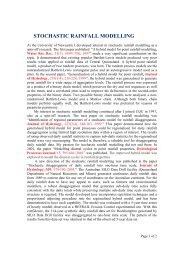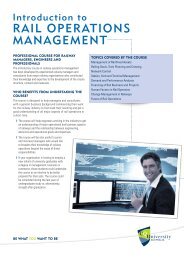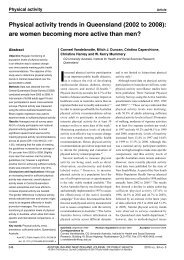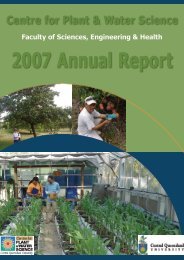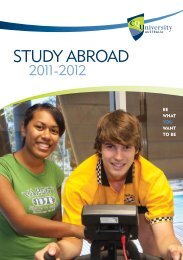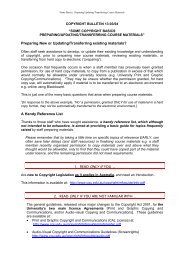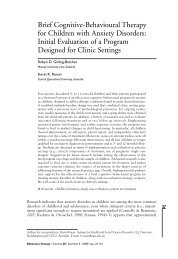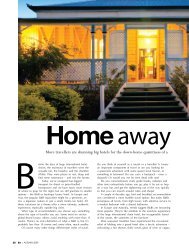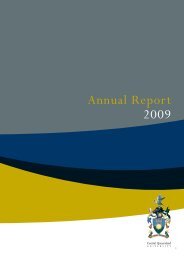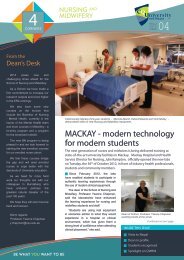CQUniversity Annual Report - Central Queensland University
CQUniversity Annual Report - Central Queensland University
CQUniversity Annual Report - Central Queensland University
- No tags were found...
Create successful ePaper yourself
Turn your PDF publications into a flip-book with our unique Google optimized e-Paper software.
<strong>CQ<strong>University</strong></strong> ANNUAL REPORT 2012(n)(o)<strong>Central</strong> <strong>Queensland</strong> <strong>University</strong>and Controlled EntitiesNotes to the Financial Statementsfor the year ended 31 December 2012Rental revenue from the leasing of investment properties is recognised in the income statement in the periods in which it isreceivable, as this represents the pattern of service rendered through the provision of the properties.Property, plant and equipmentLand and buildings (except for investment properties – refer to note 1(m) above), infrastructure, library heritage and artcollections are shown at fair value, based on periodic, but at least triennial, valuations by external independent valuers lesssubsequent depreciation for buildings and infrastructure. During intervening years a management assessment of fair valueusing indices supplied by external valuers which are specifically tailored assessments of market trends occurring at thetime. Buildings, infrastructure and land indices and assessment were supplied by G Pyman (FAPI, MRICS) RegisteredValuer No. 1856; B MacAulay (AVAA No. 336) provided a specific assessment for Artworks. The <strong>University</strong> HeritageCollection was independently revalued during 2012 by J Harbeck, an Australian Government Cultural Gifts ProgramValuer.Any accumulated depreciation at the date of revaluation is restated proportionately with the change in the gross carryingamount of the asset so that the carrying amount of the asset after valuation equals its revalued amount. All other property,plant and equipment are stated at historical cost less depreciation. Historical cost includes expenditure that is directlyattributable to the acquisition of the items.Subsequent costs are included in the asset’s carrying amount or recognised as a separate asset, as appropriate, onlywhen it is probable that future economic benefits associated with the item will flow to the Group and the cost of the itemcan be measured reliably. All other repairs and maintenance expenses are charged to the income statement during thefinancial period in which they are incurred.Increases in the carrying amounts arising on revaluation of land, buildings, infrastructure, library heritage and art collectionsare credited to reserves in equity. To the extent that the increase reverses a decrease for that class previously recognisedin profit or loss, the increase is first recognised in profit and loss. Decreases that reverse previous increases of the sameasset class are first charged against revaluation reserves directly in equity of the remaining reserve attributable to the assetclass; all other decreases are charged to the income statement.Asset classes land, library heritage and art collections are not depreciated. Depreciation on other assets is calculatedusing the straight-line method to allocate their cost or revalued amounts, net of their residual values, over their remaininguseful lives as follows: freehold buildings 2 to 59 years infrastructure 2 to 39 years leasehold improvements 1 to 16 years plant and equipment 4 to 25 yearsThe assets’ residual values and useful lives are reviewed annually, and adjusted if appropriate.An asset’s carrying amount is written down immediately to its recoverable amount if the asset’s carrying amount is greaterthan its estimated recoverable amount. Gains and losses on disposal are determined by comparing proceeds with carryingamount. These are included in the income statement. Where revalued assets are sold, it is Group policy to transfer theamounts included in other reserves in respect of those assets to retained earnings.Intangible assetsIntangible assets with a cost or other value equal to or greater than $100,000 are recognised in the financial statements,items with a lesser value being expensed. Each intangible asset is amortised over its estimated useful life to the Group,less any anticipated residual value. The residual value is zero for all the Group’s intangible assets.It has been determined that there is no active market for any of the Group’s intangible assets. As such, the assets arerecognised and carried at cost less accumulated amortisation and accumulated impairment losses.No intangible assets have been classified as held for sale or form part of the disposal group held for sale.Purchased softwareSoftware development costs in excess of $100,000 are recognised as an asset on acquisition only when the consolidatedentity controls future economic benefits as a result of the costs incurred that are probable and can be measured reliably.Costs attributable to feasibility assessments are expensed as incurred. The costs capitalised include the cost of materials,direct labour, directly attributable overheads and other incidental costs incurred. The purchase cost of this software is beingamortised on a straight-line basis over the period of the expected benefit to the university, namely 3 to 5 years.17ANNUAL FINANCIAL STATEMENTS





